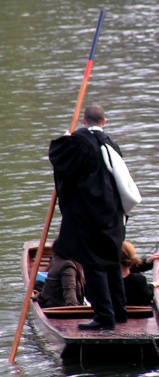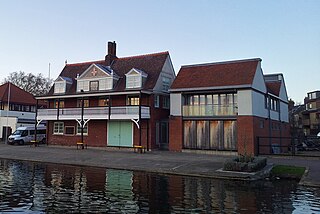
The national flag of Norway is red with a navy blue Scandinavian cross bordered in white that extends to the edges of the flag; the vertical part of the cross is shifted to the hoist side in the style of the Dannebrog, the flag of Denmark.

White tie, also called full evening dress or a dress suit, is the most formal evening Western dress code. For men, it consists of a black tail coat worn over a white dress shirt with a starched or pique bib, white piqué waistcoat and the white bow tie worn around a standing wing collar. Mid or high-waisted black trousers with galon, a braid of trim consisting of two silk stripes to conceal the outer seams of the trousers, along with court shoes complete the outfit. Orders, decorations and medals may be worn. Acceptable accessories include a black top hat, white gloves, a white scarf, a pocket watch, a white pocket square, and a boutonnière. Women wear full-length ball or evening gowns with evening gloves and, optionally, tiaras, jewellery, and a small handbag.

The national flag of Zambia was adopted upon independence on 24 October 1964, by the first Republican President Dr. Kenneth David Kaunda. Before that, Zambia was the British protectorate of Northern Rhodesia and used a defaced Blue Ensign as its flag.

Sporting colours or just colours are awarded to members of a university or school who have excelled in a sport. Many schools do not limit their use to sport but may also give colours for academic excellence or non-sporting extra-curricular activities, Colours are traditionally indicated by the wearing of a special tie or blazer.

The University of Cambridge has a long tradition of academic dress, which it traditionally refers to as academical dress. Almost every degree which is awarded by the University has its own distinct gown in addition to having its own hood. Undergraduates wear college gowns, which are all subtly different; these differences enable the wearer's college to be determined. Academic dress is worn quite often in Cambridge on formal, and sometimes informal, occasions, and there are a number of rules and customs governing when and how it is worn. Black gowns (undress) are worn at less formal events, while on special occasions full academical dress is worn, consisting of gown, hood and headdress with Doctors in festal dress. The University's officials also have ancient forms of academic dress, unique to the University.

The wearing of academic scarves is a tradition found at many colleges and universities in English-speaking countries, and particularly in the United Kingdom and Ireland. Sets of two or more coloured stripes have traditionally been used as part of the distinctive visual identity of these institutions. The scarves are usually made of Saxony wool and traditionally 6 feet long. The traditional vertical stripes were adopted first at the University of Cambridge during the Second World War when material scarcity created scarves made of strips of wool sewn together rather than woven into the fabric.

Morning dress, also known as formal day dress, is the formal Western dress code for day attire, consisting chiefly of, for men, a morning coat, waistcoat, and formal trousers, and an appropriate gown for women. Men may also wear a popular variant where all parts are the same colour and material, often grey and usually called "morning suit" or "morning grey" to distinguish it; considered properly appropriate only to festive functions such as summer weddings and horse races, which consequently makes it slightly less formal. The correct hat would be a formal top hat, or if on less spacious audience settings optionally a collapsible equivalent opera hat.

A blazer is a type of jacket resembling a suit jacket, but cut more casually. A blazer is generally distinguished from a sport coat as a more formal garment and tailored from solid colour fabrics. Blazers often have naval-style metal buttons to reflect their origin as jackets worn by boating club members.
A blue is an award of sporting colours earned by athletes at some universities and schools for competition at the highest level. The awarding of blues began at Oxford and Cambridge universities in England. They are now awarded at a number of other British universities and at some universities in Australia and New Zealand.

The Cambridge University Boat Club (CUBC) is the rowing club of the University of Cambridge, England. The club was founded in 1828 and has been located at the Goldie Boathouse on the River Cam, Cambridge since 1882. Nowadays, training primarily takes place on the River Great Ouse at Ely.
Palatinate or palatinate purple is a purple colour associated with Durham University and the County and City of Durham. The term has been used to refer to a number of different shades of purple. The Oxford English Dictionary defines it as a "light purple or lavender colour", which is used for Durham academic hoods. For corporate purposes Durham University uses a darker shade.
There are a number of universities in Queensland, Australia, all with distinct academic dress.

Carolina blue is the shade of blue used as one of the official school colors of the University of North Carolina.

Varieties of the color green may differ in hue, chroma or lightness, or in two or three of these qualities. Variations in value are also called tints and shades, a tint being a green or other hue mixed with white, a shade being mixed with black. A large selection of these various colors is shown below.

Varieties of the color blue may differ in hue, chroma, or lightness, or in two or three of these qualities. Variations in value are also called tints and shades, a tint being a blue or other hue mixed with white, a shade being mixed with black. A large selection of these colors are shown below.

Sky blue refers to a collection of shades comparable to that of a clear daytime sky. Typically it is a shade of cyan or light teal, though some iterations are closer to light blue. The term is attested from 1681. A 1585 translation of Nicolas de Nicolay's 1576 Les navigations, peregrinations et voyages faicts en la Turquie includes "the tulbant [turban] of the merchant must be skie coloured".

Oxford Blue is the official colour of the University of Oxford. The official Oxford branding guidelines set its definition as Pantone 282, equivalent to the hex code #002147.

The academic dress of McGill University describes the caps, gowns and hoods which are prescribed by the university for its degree candidates/holders. Until the mid-20th century, McGill also prescribed academic dress for its matriculating or enrolled students as well as its faculty. Founded in 1821, McGill University is consistently ranked as one of Canada's pre-eminent universities, and among the top 20 universities in the world.

The national colours of Canada are red and white, the former being symbolic of England and the latter of France, the colours having been used representatively by those countries in the past. The maple is one of the national symbols and red is both the first leaf colour after spring budding and the autumn colour of maple leaves. The colours are most prominently evident on the national flag of Canada and it has been said they were declared the country's official colours when King George V proclaimed his Canadian coat of arms in 1921. However, there is no mention of national colours in the proclamation. Similarly, the creation of Queen Elizabeth II's royal standard in 1962 is also considered to be when red and white were unofficially set as the national colours.













